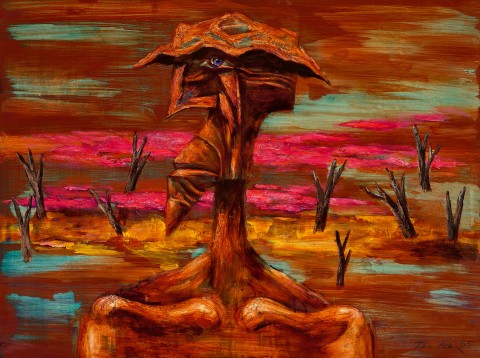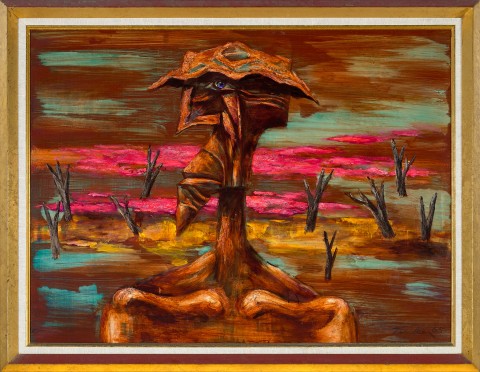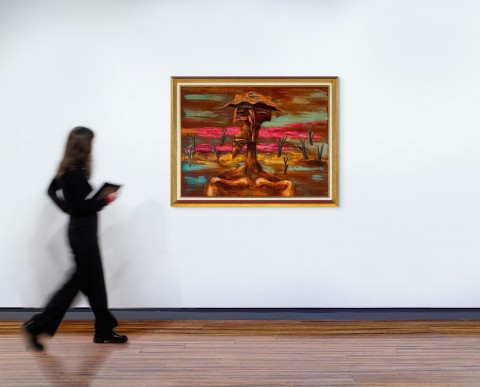EXPLORER, EVENING, 1965
ALBERT TUCKER
synthetic polymer paint on composition board
91.0 x 122.0 cm
signed and dated lower right: Tucker '65
dated and inscribed verso: INTRUDER "EXPLORER, EVENING" / 1965
Estate of Albert Tucker, Melbourne
Thence by descent
Barbara Tucker, Melbourne
Bonhams and Goodman, Melbourne
The Estate of the Late Alan Cardy, Sydney, acquired from the above 7 December 2007
Uhl, C., Albert Tucker, Lansdowne Press, Melbourne, 1969, cat. 18.39, pl. 14 I, pp. 44, 45 (illus., as 'Intruder'),106
Explorer Evening, 1966, synthetic polymer paint on composition board, 122.0 x 152.5 cm
Albert Tucker left Australia bound for London in late 1947, recalling that, ‘for me it was like undoing a coiled spring. You could go and see and experience things you had only known by report.’1 He spent the next thirteen years living and working in Europe and America, absorbing everything he could of the art, history and rich cultures of cities like Paris, Rome and New York. Tucker found that distance from Australia gave him a different perspective on the country of his birth, and during these years, as well as experimenting with various techniques, he introduced new themes to his work which responded to the distinctive history and landscape of Australia. ‘I’d been away long enough to be suffering acute bouts of nostalgia and I was getting all these memory images of Australia – and oddly enough not so much specific imagery, but in images of texture and colour and light and all that kind of thing that’s very Australian, very rough textures.’2
The subject of the figure in the landscape first appeared in Tucker’s oeuvre in the Ned Kelly series of the mid-1950s. He began painting his now iconic antipodean heads – whose distinctive form was based on the shape of an archaic Etruscan double-headed axe – towards the end of the decade. The face of this 1965 explorer, with its sharp, angular features, extends this pictorial trajectory, although with the addition of a crumpled, well-worn hat and piercing blue eye it becomes more naturalistic; a stylised depiction of a familiar Australian outback type. Painted in the same colours as the surrounding landscape, the explorer merges with his environment, the deeply incised expression lines on his face like crevices in the dry earth. The searing heat is reflected in vivid shades of orange which shimmer across the canvas. While Tucker powerfully conveys a sense of struggle against the harsh landscape, his stoic figure also symbolises resilience and survival, characteristics which are arguably just as necessary for contemporary artists as they were for colonial explorers.
By the time Tucker returned to Australia in 1960, examples of his art had been acquired for both the Museum of Modern Art and the Solomon R. Guggenheim Museum in New York. Indeed, one of the two paintings in MoMA’s collection by that time, is a depiction of the ill-fated explorers Burke and Wills, who both perished in their 1860 – 61 attempt to travel from Melbourne to the Gulf of Carpentaria.3 Winning the Australian Women’s Weekly art competition that same year – and famously receiving the news that he had been awarded the 1000 pound prize at a time when he had only a few dollars left in his pocket – Tucker’s return coincided with a major survey exhibition organised by John Reed for the Museum of Modern Art of Australia, which brought due acknowledgment of his work at home and marked the beginning of broad recognition of his contribution to the history of twentieth-century Australian art.
1. Mollison, J., and Bonham, N., Albert Tucker, Macmillan, South Melbourne, 1982, p. 42
2. Harding, L., Hinterlands: Albert Tucker’s Landscape, Heide Museum of Modern Art, Bulleen, 2008, p. 31
3. Explorers, Burke and Wills, 1960, oil and sand on canvas, 122.1 x 156.1 cm, Philip Johnson Fund, Museum of Modern Art, New York (124.1960)
KIRSTY GRANT


